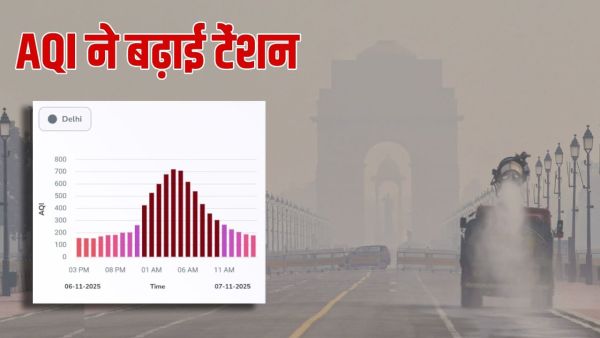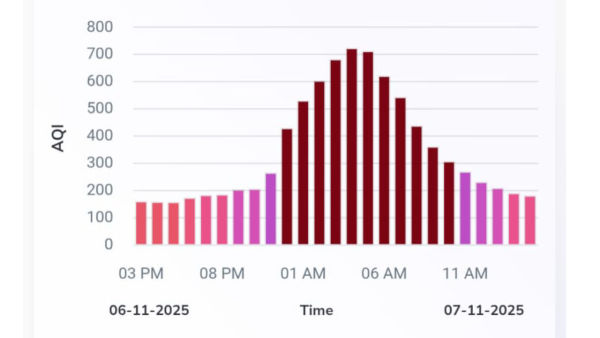
The Air Quality Index (AQI) in Delhi-NCR is making records at night.
Winter has not even arrived properly and the weather of Delhi-NCR has become very polluted. People are going out wearing masks. This has been happening for years. Who knows for how long will we have to endure this in winter? Meanwhile, another fact came to light that the air quality becomes worse at night or we can also say that the air quality is found to be worst at night.
Delhi's maximum AQI was recorded at 623 in the last 24 hours. Maximum AQI of 653 has been recorded on 8th November i.e. today at 7 am. Whereas on November 7 at 4 pm it was recorded at 175. Increase in night time Air Quality Index (AQI) is a repeatedly observed pattern in many cities of India, especially Delhi-NCR. This happens not just due to drop in temperature or number of vehicles, but due to many reasons.
Let us try to understand why AQI increases at night? What are its characteristics in the context of Delhi? What factors influence other parts of the country?
Why does this happen?
During the day, the sun's heat heats the air near the surface, causing it to rise and the pollutants mix vertically. The ground cools rapidly at night, causing the air near the surface to become cold and heavy. This situation is called Temperature Inversion. At this time the air above is relatively hot and the air below is cold. The warm layer acts like a lid and traps pollutants near the surface. The result is that pollutants like PM2.5, PM10, NO2, CO accumulate near the surface at night and spoil the AQI, whereas during the day, the AQI improves slightly when mixing increases after the sun rises.

There are many reasons behind increase in AQI at night.
wind speed
Air velocity usually decreases during night. Less air means that pollutants do not spread and become thin, but remain concentrated in a small area. North India often experiences calm winds and cool, dry conditions during the autumn to winter season (October-January), which increases stagnation. This impact is more intense in Delhi-NCR as the region is influenced by geomorphic conditions such as the Himalayan foothills, Yamuna plains, and urban valleys.
Carbon emissions do not decrease
Even after the office-traffic peak in the evening, goods vehicles run more at night to avoid daytime restrictions and congestion. Black carbon emissions from other vehicles including diesel trucks increase. In many areas, people try to simplify life by cooking food at night, collecting metal waste, burning coal, wood and garbage in unorganized dhabas and roadside stalls. Some small and medium industries operate continuously at night. Where there is less monitoring, complaints of increased emissions at night are common. Despite regulations, work continues at some construction sites at night, leading to increased dust and pollution from diesel generators.
Moisture, fog and fine particles become the reason
The humidity in the weather increases relatively at night. High humidity draws a layer of water over PM2.5 particles and makes them appear larger, increasing smog and pushing the AQI into the worse category. Night-time chemistry results from the chemical transformation of NOx, SO2 and volatile organic compounds (VOCs) into particles such as ammonium sulphate/nitrate, which further increase PM2.5 at night.
With the increase in fog in Delhi, the minimum temperature has been recorded at 11 degrees Celsius.
This factor is also no less responsible
In stubble burning in the months of October-November, smoke-laden air currents coming from Punjab-Haryana combined with stability at night push the AQI into the very poor category. The cool, calm nights and humidity of the Yamuna basin, coupled with high vehicle density, all create conditions for trapping pollutants at night.
In winter months the mixing height remains very low (sometimes 200–400 m), whereas in summer it can go up to 1000–2000 m, due to which the effect of night is more visible in winter. Delhi-NCR pattern prevails in North and Central India. But in the coastal cities of South India like Chennai, Visakhapatnam etc. the nighttime pattern of sea winds is different. Sometimes, due to reversal of land-sea breeze, pollutants settle on the coastal strip, but such an extreme situation as in North India does not occur. Inversion is strong in the valleys around Dehradun and Shillong, due to which pollutants get trapped in the lower layer at night and here too the AQI peak can be seen in the early morning.
Does this happen only in winter?
The direct answer to this is no. In summer also, inversions can occur at night, but their intensity is less and due to the large mixing height, the effect remains relatively mild. Humidity is high in monsoon, but rain and strong winds wash or blow away pollutants, so AQI spikes are less seen at night.

How to stop it?
Strict time-management and emission norms are required for heavy vehicles to enter the city. There should be arrangements for dust control covering, anti-smog guns, wheel-wash, debris covering etc. at construction sites at night. Monitoring on unorganized fuel burning should be intensified. There should be a penalty for burning coal and garbage and common people should have easy access to LPG/PNG.
Increasing grid reliability, use of gas-based gensets, battery storage as alternatives to DG sets is the need of the hour. Small and medium industries should have low-NOx burners, scrubbers, filtering and real-time emission monitoring. Mechanical road sweeping, regular water sprinkling, adherence to PUC standards, BS-VI vehicles and clean fuels should be promoted.
In this way we find that the increase in AQI at night is not the result of any single cause, but is a combined result of atmospheric conditions, local and regional emissions and seasonal-geographical factors. In Delhi-NCR, this effect is most visible in autumn and winter seasons. In other parts of the country also the night AQI increases according to the local context.
Inversions in valleys, breeze patterns in coastal cities, and nighttime activities in industrial cities play a role. The way to the solution is to have data based management. Targeted control should be done at sensitive times like night and morning. Small changes should be made in the clean energy transition and civic and institutional conduct.
-
Scones will be tastier and richer if you add 1 simple ingredient to the dough chef loves

-
PF Balance: The easiest way to check PF balance from your mobile, no internet required...

-
PM Modi interacts with students on board Vande Bharat train in Varanasi

-
Bettiah voters keenly await PM Modi's arrival for poll rally

-
Man arrested for repeated sexual assault of 14-year-old daughter at home in Bengal's Usthi
